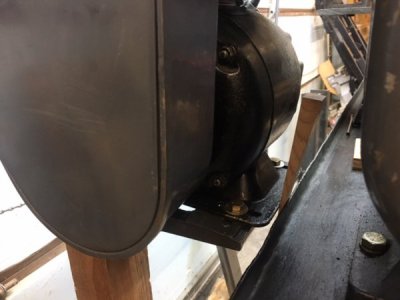Since I've set up my Logan 816 it's had more vibration that I thought it should (although I've never been around a running metal lathe....). It has the three speed cones. High and low speeds are pretty smooth, but on middle speed it vibrates like the washer on spin cycle with a tennis shoe in there. Enough that if I put a tool on the pulley cover (which I imagine you shouldn't anyway) will quickly rattle off. I'm pretty sure it's a motor harmonic thing, as when the high speed spools up, it vibrates as it speeds up, then is smooth. Upon power down, it shudders again when passing through that RPM.
I've isolated it to the drive side. The motor, with the v-belt off, runs smoothly. If I lift the pulley cover, move the flat belt off to the side so it doesn't engage, engage the v-belt and run the motor, the countershaft spins smoothly until I put pressure on it, simulating lowering the cover to tension the belts. Then the vibration starts.
I've replaced the v-belt, the countershaft pulley, as well as the countershaft and the bushings. No change. I tried every combination of belt tension and no change. I've been living with it, but it's annoying and it will leave marks in the work sometimes.
Today I thought maybe the motor position somehow had something to do with it. This is a bench model that was converted to a stand, with the motor supported by a wood post. The motor mount is about 1/4" from the chip pan, so with the lathe running I stuck a screwdriver in the gap as a lever and slightly lifted the motor. The vibration decreased! So I spent some time raising and lowering the motor with the screw on the back, but the vibration continued. Then I figured out that it was actually sticking the screwdriver in that gap. If I wedged it in there, the vibration lessened to what I guess is "normal."
So here is my "fix", which seems to be working:

My point is to ask if anyone has had this issue, as well as to ask if I'm missing something obvious, or if this solution will somehow cause some harm to something. I guess the wedge puts some pressure on the motor and dampens the vibrations. If it's not a big issue I suppose I could come up with a strap to bolt between the two parts.
I've isolated it to the drive side. The motor, with the v-belt off, runs smoothly. If I lift the pulley cover, move the flat belt off to the side so it doesn't engage, engage the v-belt and run the motor, the countershaft spins smoothly until I put pressure on it, simulating lowering the cover to tension the belts. Then the vibration starts.
I've replaced the v-belt, the countershaft pulley, as well as the countershaft and the bushings. No change. I tried every combination of belt tension and no change. I've been living with it, but it's annoying and it will leave marks in the work sometimes.
Today I thought maybe the motor position somehow had something to do with it. This is a bench model that was converted to a stand, with the motor supported by a wood post. The motor mount is about 1/4" from the chip pan, so with the lathe running I stuck a screwdriver in the gap as a lever and slightly lifted the motor. The vibration decreased! So I spent some time raising and lowering the motor with the screw on the back, but the vibration continued. Then I figured out that it was actually sticking the screwdriver in that gap. If I wedged it in there, the vibration lessened to what I guess is "normal."
So here is my "fix", which seems to be working:

My point is to ask if anyone has had this issue, as well as to ask if I'm missing something obvious, or if this solution will somehow cause some harm to something. I guess the wedge puts some pressure on the motor and dampens the vibrations. If it's not a big issue I suppose I could come up with a strap to bolt between the two parts.

